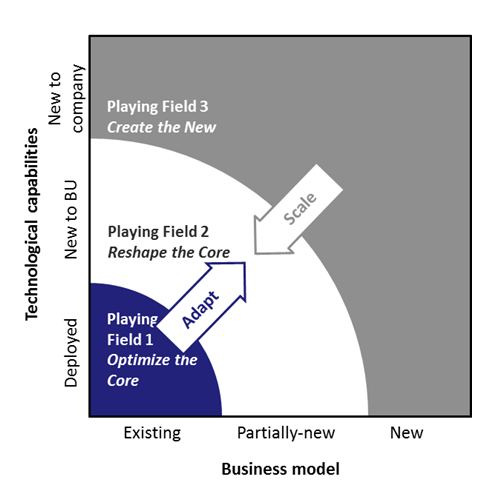Being faced with disruption and increasing pace of change, many established companies fail to keep up. They often turn out to be ill-prepared to innovate under uncertain and time-critical conditions. Rather than going it alone, some companies reach out to suitable partners with the aim to build up innovation ecosystems that complement the companies’ capabilities, competences and strategies. A decisive question is: What types of ecosystems will work best in particular innovation environments?
Centralized vs. Adaptive Ecosystems
Nathan Furr and Andrew Shipilov recently published research findings that shed light on this forward-looking issue. They found that two ‘archetypes’ of ecosystems can be distinguished, whose distinct sets of characteristics are displayed in the table below:
- Centralized Ecosystem (Broker): A company functions as a hub to connect partners while keeping them separate and forcing them to work through itself. Example: Mastercard interacts seamlessly with a long list of banks and merchants that use Mastercard’s infrastructure to process payments from its customers.
- Adaptive Ecosystem (Orchestrator): A company connects multiple partners and encoturages them to work directly with each other. Example: Mastercard has recently started developing new offerings tailored to emerging consumer needs around commuting experience together with partners from public transportation and retailers in the consumer goods business.
With regard to the question above, the authors conclude:
Ecosystems need to align with an industry’s life cycle. Adaptive ecosystems are best suited to emerging industries where there are significant uncertainties and the broader environment is not yet well-defined. Centralized ecosystems work for mature industries and stable contexts. Over time, a company’s ecosystem strategy will evolve: As industries that were once unsettled begin to mature and the value-creation patterns become more established, companies may move toward favoring centralized management over adaptive models. How this pattern plays out will vary from ecosystem to ecosystem.
Dual Innovation requires Dual Ecosystem Strategy
A modern approach to Dual Corporate Innovation is based on Three Playing Fields and two strategic Directions of Play, involving non-incremental innovation activities:
- Adapt: Adaptation of established core business or operating models (e.g. Digital Transformation)
- Scale: Scaling-Up of validated radical or even disruptive innovation concepts (e.g. a new-to-company technology or business model) to translate them into tangible business impact
These two innovation streams, feeding Playing Field 2 (Reshape the Core), jointly determine how today’s core business is reshaped – or transformed – into tomorrow’s business. Designing Playing Field 2 adequately to provide a dedicated environment for those reshaping activities to come off, can be viewed as key challenge in modern corporate innovation management.
How can innovation activities across this ‘Three Playing Fields’-portfolio (in particular the make-or-break ventures accomodated in the critical, integrating middle ground) harness the right partner ecosystems to thrive? By tieing the Playing Fields’ distinct scopes and purposes to the characteristics of the two ecosystem types in the table above, we can draw up the following correspondence:
- Optimize the Core (Playing Field 1) relies on centralized ecosystem strategy (key features: specific and well-defined problems/solutions, partners with tie-ins to existing business model, value capture focus, stable industry boundaries)
- Create the New (Playing Field 3) relies on adaptive ecosystem strategy (key features: partners with unfamiliar capabilities, value creation focus, shifting industry boundaries)
- Reshape the Core (Playing Field 2) relies on a blended ecosystem strategy (pursuing both above strategies concurrently or consecutively)
In essence, this can be boiled down to a Dual Ecosystem Strategy: Centralized ecosystems can be associated with core-related innovation activities aiming at developing existing businesses, while adaptive ecosystems seem favorable for complementary explorative innovation activities aiming at tapping into novel, emerging opportunities.
Takeaway
Nowadays, companies can’t go it alone when it comes to bringing forth innovation effectively and efficiently. Requirements for an adequate partnership ecosystem hinge on the specific innovation scope on hand. Companies are well-advised to choose a dual strategy, splitting up into
- Broker/Hub approach for incremental innovation, optimizing and exploiting existing business models or technologies
- Orchestrator approach for radical or disruptive innovation, exploring new-to-company business models or technologies
- Blended approach for reshaping/transforming the core business through Adapt and Scale activities
Companies engaging in ecosystem strategies are building collaboration and partnership capabilities that will serve them well over the life cycles of their respective core businesses. Beyond that, discovering and leveraging new forms of value in collaboration with unfamiliar partners is likely to bring forth new opportunities and extend a company’s life span.


2 Responses to Dual Innovation Ecosystem Strategy: Broker vs. Orchestrator